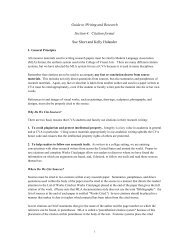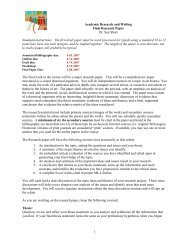Woman with a Fan: Paul Gauguin's Heavenly Vairaumati-a Parable ...
Woman with a Fan: Paul Gauguin's Heavenly Vairaumati-a Parable ...
Woman with a Fan: Paul Gauguin's Heavenly Vairaumati-a Parable ...
Create successful ePaper yourself
Turn your PDF publications into a flip-book with our unique Google optimized e-Paper software.
indicates ihe legend, but really the style." In "the virgins of<br />
Ciniabiie," lie perc(eivwd "the ridiculous beauty" that brought<br />
atheiiuicit' to this Italian Primitive's style. Ever droll, he<br />
added that "by the fact of this ridiculousness, [they] are<br />
closer to dhe phenomenon that has become dogma Uesus<br />
born of a virgin and the Holy Ghost) than any other virgin<br />
commonly celibate."8s9<br />
<strong>Vairaumati</strong>-a Marquesan Homologue of the Virgin Mary<br />
Gauigiiin's theosophical views facilitated his mergers of Chrislian<br />
andi non-Western religious figures, which multiplied in<br />
his art aierfi he arrived in the South Pacific. He adapted<br />
b)i)blical paratbles to Oceanian myths and translated Eve and<br />
hie Virgin Mary into Polynesian archetypes-as in 7'e nave<br />
nave lennaa (I)elighqf tdLand) and Ia Orana Maria (We Greet Thee<br />
Maiy). 'Th myth of <strong>Vairaumati</strong> imitates the prototype of the<br />
Virgin Mary, fiom thle Annunciation to the Assumption. In<br />
the goilache Te Earuru (To Make Love), also known as The<br />
Annunciation, thi angel takes leave of Mary in a cloud of<br />
smoke that rccalls the scene in the Ancien culte mahorie where<br />
Oro rises t(i the heavens as a pillar of fire after <strong>Vairaumati</strong><br />
annoinices her pregnancy. 1 ) As the new Eve, <strong>Vairaumati</strong><br />
assumtties Ile persona of the mother of Christ' 1 )<br />
Painted ais lie wrote the final draft of "L'esprit moderne et<br />
Ic cathilicism sie," <strong>Woman</strong> <strong>with</strong> a <strong>Fan</strong> commands the authority<br />
of an icon-a deity static on her throne, removed to the<br />
Iraiiqillity of another realm. Her queenly mien distingutishcd<br />
Ithe )ictuire from the outset.92 She is a meditation on<br />
Ihe heavcnly <strong>Vairaumati</strong>-a MarqUesan homologue of the<br />
Virgin Mary. Hler glow matches the tradition whereby the<br />
mother of( Christ, "like the other forms of the queen of<br />
hcaveti, ha([ the cllorn of the mater fiu gum, the complexion<br />
of golden corn.'" In this context, the token of Hina, the<br />
while f'ealher fan, coild perhaps double (not <strong>with</strong>out huttior)<br />
is a proxy once removed for the dove of the Holy<br />
(;host.<br />
ItI the utpper left corner of <strong>Woman</strong> <strong>with</strong> a <strong>Fan</strong>, blue organic<br />
fotrms hang fino a brown branch, resembling fruit found in<br />
oli er of (;auguin's Polynesian paintings.' 4 They are probably<br />
a muflled cveretration of the apples forbidden to Eve-the<br />
symbol of fertility at the origin of the cycle of man. Typical of<br />
his approach, i Gauguin transferred a well-established Western<br />
conveiion, such as fruit equated <strong>with</strong> knowledge and fecundity,<br />
to an Oceanian cognate that he suffuses <strong>with</strong> multiple<br />
power s if siggestion, extending from its biblical sense to the<br />
Ma0ii myth, finally to resonate as a metasymbol of creativity.f<br />
Ih'ic intersection of the narratives of <strong>Vairaumati</strong> and the<br />
Virgin Mary reach their consummate synthesis in <strong>Woman</strong> <strong>with</strong><br />
a Pan. Gauguiii entwined the identities of these two mortal<br />
women elevated to their respective kingdoms, not to make<br />
Vairauniati into the Virgin Mary but to legitimate her as a<br />
metal)hor of the soul's immortality.<br />
A <strong>Parable</strong> of Immortality<br />
As his hcalth declined, Gauguin was immersed in contemplating<br />
the fate of the soul and the longevity of art. His near<br />
obsession <strong>with</strong> his posthumous renown intensified as he<br />
seused hiniseI fnarginalized in a remote corner of the globe.<br />
WOMAN WITH A /AN: PAUL (GAUG.tlN'S HFAVENLY VAIRAUtNATI 563<br />
He felt compelled to ensure that his reputation as the maverick<br />
hero of the Parisian avant-garde would not fade <strong>with</strong> his<br />
demise. That he wrote three books in the last year of his life<br />
betrays his gnawing fear that he might be in danger of being<br />
forgotten. And he set about making pictures that he hoped<br />
would crystallize the audacity of his innovations. His contributions<br />
had to be comprehensible to his audience if he were<br />
to be remembered for "the right to dare all."<br />
Vested <strong>with</strong> the emblem of liberty, <strong>Woman</strong> <strong>with</strong> a <strong>Fan</strong> serves<br />
as a beacon to propagate his claims to posterity. As the<br />
summation of the myth of <strong>Vairaumati</strong>, the figure not only<br />
commemorates the debut of his Tahitian cult themes, she is<br />
also the most human metamorphosis of a cherished motif<br />
from his visual repertoire. Her corporeal transformation in<br />
the myth is comparable to the evolution of the pose, rooted<br />
in Puvis's Hope, that Gauguin modified in consecutive paintings<br />
from 1892 to 1902. The regeneration epitomized in the<br />
heavenly <strong>Vairaumati</strong> is literally implemented in the pictorial<br />
dynamic through the mutation of the manifold sources that<br />
constitute her identity. Consequently, <strong>Woman</strong> <strong>with</strong> a fian exemplifies<br />
the premise of transposition, tying the permutations<br />
of art to the immortality of the soul.<br />
Thus Gauguin embedded meaning into the pictorial field<br />
in <strong>Woman</strong> <strong>with</strong> a <strong>Fan</strong>. The attributes-fan, fruit, throne-are<br />
merely signposts pointing to the mythical identity of the<br />
sitter, while the transformation of motifs and formal elements<br />
integral to the construction of the painting determines its<br />
value as a parable illuminating the creative process. Disparate<br />
components-a patriotic insignia, a Polynesian myth, an exotic<br />
fan, a Byzantine altar, a recent painting-are transformed<br />
<strong>with</strong> a freedom of handling that contradicts the<br />
inherited traditions and polished detail of the academy. Gaugurn<br />
mingled artistic sources in a freewheeling fashion akin<br />
to his syncretic approach to religion, a theosophical potpourri<br />
of Christian, Hindu, Buddhist, and Polynesian ideas<br />
mixed into an unorthodox faith that suited his personal<br />
circumstances. For him, the renewal of art through transposition<br />
became synonymous <strong>with</strong> that of the soul through<br />
metempsychosis, uniting his aesthetic and religions beliefs in<br />
a parable of immortality. In an era that replaced religion <strong>with</strong><br />
art, Gauguin proposed a paradigm that fused them.<br />
For Gauguin art was as deeply subjective as religion. <strong>Woman</strong><br />
<strong>with</strong> a <strong>Fan</strong> reverberates <strong>with</strong> nuances, "like dreams, an assemblage<br />
more or less formed from things or thoughts<br />
glimpsed."96 His viewers are empowered to share the wonan's<br />
compelling reverie, emotionally sustained by the abstract<br />
ingredients of color and technique. Through the medium of<br />
the parable, veiled in poetic ambiguity, the painting engenders<br />
a dialogue pertinent to the mysteries of human existence.<br />
Just as <strong>Vairaumati</strong> represents the individual who attains<br />
immortality in <strong>Gauguin's</strong> Tahitian pantheon, her<br />
transfiguration in his oeuvre signifies the vitality of his artistic<br />
achievement. Her pictorial reincarnation is the "new link in<br />
the chain" that connects his art to the twentieth century. All<br />
aspects of <strong>Woman</strong> <strong>with</strong> a <strong>Fan</strong>, from its subject to the handling,<br />
conspire to secure Gauguin a place in the continuum of art<br />
history. The synthesis is crncial to his definition of transposition,<br />
where the liberties taken <strong>with</strong> the art of the past provide<br />
posterity <strong>with</strong> a benchmark for his accomplishments. At stake<br />
is the premise of his own immortality.





